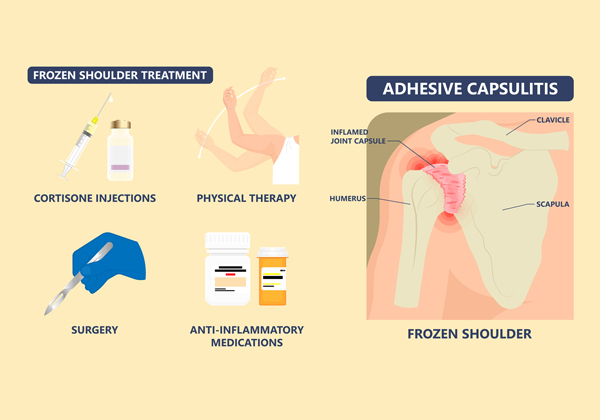Understanding and Managing Frozen Shoulder: Reclaim Your Shoulder Movement
Overview
Have you noticed a gradual stiffening and pain in your shoulder, making it difficult to move your arm? This could be a sign of frozen shoulder, a condition affecting the shoulder joint capsule.
What is a Frozen Shoulder?
A frozen shoulder, also known as adhesive capsulitis, occurs when the capsule surrounding your shoulder joint becomes inflamed and thickened. This restricts the movement of the joint, causing pain and stiffness.
Understanding Your Shoulder
The shoulder is a complex joint formed by three bones – the upper arm bone (humerus), shoulder blade (scapula), and collarbone (clavicle). The capsule surrounding the joint holds everything together and allows for smooth movement.
What Causes a Frozen Shoulder?
The exact cause of frozen shoulder is unknown, but several factors can increase your risk, including:
- Age: More common between 40 and 60 years old.
- Gender: Women are slightly more susceptible.
- Medical conditions: Diabetes, heart disease, thyroid issues, or Parkinson’s disease can increase risk.
- Immobility: Recovery from stroke, surgery, or other conditions limiting arm movement can trigger it.
Symptoms of Frozen Shoulder
- Pain: Often worse at night, hindering sleep.
- Stiffness: Difficulty moving the arm in various directions, restricting daily activities.
Diagnosing Frozen Shoulder
Your doctor will usually diagnose frozen shoulder based on a physical examination. X-rays, ultrasounds, or MRIs might be used to exclude other conditions like arthritis or torn rotator cuff.
Treatment Options
-
The primary goal of treatment is to manage pain and regain shoulder movement. Your doctor may recommend:
- Anti-inflammatory medications (NSAIDs): To reduce pain and inflammation.
- Physical therapy: Gentle stretching and strengthening exercises to improve mobility.
- Corticosteroid injections: To reduce inflammation directly within the joint.
- Hydrodilatation: Injecting sterile fluid into the capsule to stretch it and facilitate movement.
- Manipulation under anesthesia: Involves controlled stretching of the capsule while under anesthesia.
- Arthroscopic surgery: A minimally invasive procedure to remove scar tissue and improve flexibility.
Recovery
Recovery is gradual and requires commitment to your therapy program. Physical therapy is crucial to maintain the regained movement and could take several weeks or months.
Remember
Frozen shoulder is a manageable condition. Timely diagnosis and adherence to treatment recommendations can help you regain functional and pain-free movement in your shoulder.

